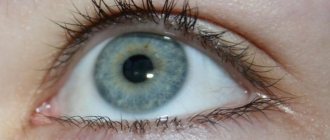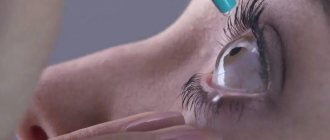Release form, composition and packaging
Eye drops 0.005% transparent, colorless.
| 1 ml | |
| latanoprost | 50 mcg |
Excipients: disodium hydrogen phosphate dodecahydrate, sodium dihydrogen phosphate dihydrate, sodium chloride, benzalkonium chloride, purified water.
2.5 ml - polymer dropper bottle (1) - cardboard packs.
pharmachologic effect
Antiglaucoma drug. It is an analogue of prostaglandin F2α and a selective agonist of FP receptors.
Reduces intraocular pressure by increasing the outflow of aqueous humor, mainly along the uveoscleral pathway, as well as through the trabecular meshwork. It does not have a significant effect on the production of aqueous humor and does not affect the blood-ophthalmic barrier.
The decrease in intraocular pressure begins 3-4 hours after administration of the drug, the maximum effect is observed after 8-12 hours, the effect continues for at least 24 hours.
GLAUPROST: SIDE EFFECTS
From the organ of vision: eye irritation (burning sensation, feeling of sand in the eyes, itching, tingling and foreign body sensation), blepharitis, conjunctival hyperemia, eye pain, increased pigmentation of the iris, transient pinpoint erosion of the epithelium, swelling of the eyelids, swelling and erosion of the cornea , conjunctivitis, elongation, thickening, increase in the number and intensification of pigmentation of eyelashes and vellus hair, iritis/uveitis, keratitis, macular edema (including cystoid), change in the direction of eyelash growth, sometimes causing eye irritation, blurred vision.
Dermatological reactions: rash, darkening of the skin of the eyelids and local skin reactions on the eyelids.
From the nervous system: dizziness, headache.
From the respiratory system: bronchial asthma (including acute attacks or exacerbation of the disease in patients with a history of bronchial asthma), shortness of breath.
Side effects
- Eye irritation, accompanied by a burning sensation, a feeling of sand in the eyes, itching, tingling and a sensation of the presence of a foreign body; eye pain, blepharitis, conjunctival hyperemia, pinpoint erosion of the epithelium, increased pigmentation of the iris, swelling of the eyelids, corneal erosion, lengthening, thickening, increase in the number of eyelashes, increased pigmentation, conjunctivitis, iritis/uveitis, keratitis, cystoid macular edema, blurred vision.
- Darkening of the skin of the eyelids, skin reactions, rash.
- Dizziness, headache.
- Bronchospasm, shortness of breath.
- Pain in joints and muscles.
- Chest pain.
Contraindications
- age under 18 years;
- hypersensitivity to the components of the drug.
The drug should be used with caution in patients with aphakia, pseudophakia with rupture of the posterior capsule of the lens, in patients with known risk factors for macular edema (cases of development of macular edema, including cystoid, have been described during treatment with latanoprost), in patients with inflammatory, neovascular or congenital glaucoma (due to lack of sufficient experience in using the drug).
Glauprost (eye drops 0.005% flask 2.5 ml No. 3)
A country
Romania
The country of production may vary depending on the batch of goods. Please check with the operator for detailed information when confirming your order.
Compound
Bottle 2.5 ml
Latanoprost 50 mcg per 1 ml. Excipients: disodium hydrogen phosphate dodecahydrate - 17 mg, sodium dihydrogen phosphate dihydrate - 7 mg, sodium chloride - 3 mg, benzalkonium chloride - 0.2 mg, purified water - up to 1 ml. Eye drops are transparent, colorless.
pharmachologic effect
Antiglaucoma drug. Is it an analogue of prostaglandin F2? and a selective FP (prostaglandin F) receptor agonist. Reduces intraocular pressure by increasing the outflow of aqueous humor. The decrease in intraocular pressure begins 3-4 hours after administration of the drug, the maximum effect is observed after 8-12 hours, the effect lasts for at least 24 hours. Studies in animals and humans have shown that the main mechanism of action is an increase in uveoscleral outflow, in addition , improved outflow (reduced outflow resistance) has also been described in humans. It has been established that latanoprost does not have a significant effect on the production of aqueous humor and the blood-ophthalmic barrier. Animal studies have shown that in therapeutic doses, latanoprost does not affect (or only slightly) the intraocular circulation. When applied topically, mild to moderate conjunctival or episcleral injection is possible. According to fluorescein angiography, long-term treatment with latanoprost after extracapsular cataract extraction in monkeys had no effect on retinal blood circulation. When used short-term, latanoprost did not promote fluorescein leakage in the posterior segment of the eye of patients with artificial lenses. When used in therapeutic doses, latanoprost does not have a significant pharmacological effect on the cardiovascular and respiratory systems.
Indications for use
Reduction of elevated intraocular pressure (IOP) in adults and children (over 1 year of age) with open-angle glaucoma or ocular hypertension.
Mode of application
Adults (including elderly patients) 1 drop into the affected eye(s) 1 time/day. The optimal effect is achieved when using the drug in the evening. The drug should not be instilled more often than once a day, since more frequent administration has been shown to reduce the hypotensive effect. If one dose is missed, treatment is continued as usual. As when using any eye drops, in order to reduce the possible systemic effect of the drug, immediately after instillation of each drop, it is recommended to press for 1 minute on the lower lacrimal opening, located at the inner corner of the eye on the lower eyelid. This procedure must be performed immediately after instillation. Before instillation, it is necessary to remove contact lenses and install them no earlier than 15 minutes after insertion. If several ophthalmic dosage forms are used simultaneously, their use should be separated by a 5-minute interval. Children Latanoprost is used in children in the same dose as in adults. Data on the use of the drug in premature infants (gestational age Interaction) There are no unambiguous data on the drug interaction of latanoprost. With the simultaneous instillation of two prostaglandin analogues, a paradoxical increase in IOP has been described, therefore the simultaneous use of two or more prostaglandins, their analogues or derivatives is not recommended. In vitro studies have shown that When mixing eye drops containing thiomersal with eye drops containing latanoprost, a precipitate is formed. If it is necessary to use these drugs simultaneously, a 5-minute interval between their instillation should be observed.
Side effect
Most of the adverse reactions were observed in the organ of vision. In an open-label 5-year safety study, 33% of patients developed iris pigmentation. Other undesirable reactions from the organ of vision are usually transient and are noted immediately after instillation. The gradation of adverse reactions according to frequency of occurrence was carried out as follows: very often (>1/10); often (?1/100, Infections and infestations: frequency unknown - herpetic keratitis. From the organ of vision: - very often - hyperpigmentation of the iris, conjunctival hyperemia, mild to moderate eye irritation (burning sensation, feeling of sand in the eyes, itching , tingling and sensation of a foreign body), changes in eyelashes (increase in length, thickness, number and pigmentation); - often - transient point erosions of the epithelium (mostly asymptomatic), blepharitis, pain in the eye; - infrequently - swelling of the eyelids, dryness of the mucous membrane of the eye, keratitis, blurred vision, conjunctivitis; - rarely - iritis/uveitis (mainly in predisposed patients), macular edema, eyelid edema, corneal edema, corneal erosion, periorbital edema, darkening of the eyelid skin, eyelid skin reactions, change in the direction of eyelash growth, thickening, darkening and lengthening of eyelashes, distichiasis, photophobia; - very rarely - changes in the periorbital area and in the eyelash area, leading to a deepening of the furrow of the upper eyelid; — frequency unknown — iris cyst. From the nervous system: frequency unknown - dizziness, headache. From the cardiovascular system: - very rarely - aggravation of angina in patients with concomitant angina; — frequency unknown — feeling of heartbeat. From the respiratory system: rarely - bronchospasm (including exacerbation of the disease in patients with a history of bronchial asthma), shortness of breath. From the skin and subcutaneous tissues: - uncommon - rash; - rarely - darkening of the skin of the eyelids and local skin reactions on the eyelids. From the musculoskeletal system: frequency unknown - myalgia, arthralgia. Other: very rarely - chest pain. Children According to the results of two short-term (?12 weeks) clinical studies in 93 children, the safety profile of latanoprost in children did not differ from the safety profile in adults. The safety profile between different age groups in children is comparable. Compared with the adult population, nasopharyngitis and fever were most frequently reported in children.
Contraindications
- hypersensitivity to the components of the drug; - age up to 1 year (efficacy and safety have not been established); - pregnancy; - lactation period. The drug should be used with caution in patients with aphakia, pseudophakia with rupture of the posterior capsule of the lens, in patients with known risk factors for macular edema (cases of development of macular edema, including cystoid, have been described during treatment with latanoprost), in patients with inflammatory, neovascular or congenital glaucoma (due to lack of sufficient experience in using the drug).
Overdose
Symptoms: in addition to irritation of the mucous membrane of the eyes and hyperemia, other undesirable reactions from the organ of vision with an overdose of latanoprost have not been described. If you accidentally take latanoprost orally, the following information should be taken into account: one bottle of 2.5 ml of solution contains 125 mcg of latanoprost. More than 90% of latanoprost is metabolized during the “first pass” through the liver. IV infusion at a dose of 3 mcg/kg in healthy volunteers did not cause any symptoms, but when a dose of 5.5-10 mcg/kg was administered, nausea, abdominal pain, dizziness, fatigue, hot flashes and sweating were observed. IV administration of latanoprost to monkeys at a dose of 500 mcg/kg did not cause significant effects on the cardiovascular system. IV administration of latanoprost to monkeys caused transient bronchospasm. In patients with moderate bronchial asthma, instillation of latanoprost into the eyes at a dose 7 times higher than the therapeutic dose did not cause bronchospasm. Treatment: symptomatic therapy.
special instructions
The use of latanoprost can gradually change eye color by increasing the amount of brown pigment in the iris. Before starting treatment, patients should be informed about the possible permanent change in eye color. Using the drug in one eye may cause irreversible heterochromia. This effect occurs predominantly in patients with mixed iris colors, such as blue-brown, gray-brown, green-brown, or yellow-brown. In studies of latanoprost, darkening usually began within the first 8 months of treatment, rarely during the second or third year, and was not observed after 4 years of treatment. The progression of iris pigmentation decreased over time and stabilized after 5 years. There is no data on increased pigmentation over 5 years. In a 5-year open-label safety study of latanoprost, 33% of patients developed iris pigmentation. In most cases, the change in iris color was minor and often not clinically detected. The incidence ranges from 7% to 85% in patients with mixed iris color, predominant in patients with yellow-brown iris. No changes were observed in patients with a uniformly colored blue iris; in rare cases, changes were observed in uniformly colored gray, green and brown irises. The change in eye color is caused by an increase in the melanin content in the stromal melanocytes of the iris, and not by an increase in the number of melanocytes themselves. In typical cases, brown pigmentation appears around the pupil and extends concentrically to the periphery of the iris. In this case, the entire iris or parts of it become brown. After discontinuation of therapy, no further pigmentation was noted. According to available clinical data, the color change was not associated with any symptoms or pathological disorders. The drug has no effect on nevi and lentigines of the iris. According to the results of 5-year clinical studies, pigment accumulation in the sclero-corneal trabecular meshwork or other parts of the anterior chamber of the eye was not noted. It has been shown that darkening of the iris does not lead to undesirable clinical consequences, so the use of latanoprost when such darkening occurs can be continued. However, such patients should be monitored regularly and, depending on the clinical situation, treatment may be discontinued. Experience with the use of latanoprost in the treatment of angle-closure and congenital glaucoma, pigmentary glaucoma, and open-angle glaucoma in patients with pseudophakia is limited. There is no information on the use of latanoprost in the treatment of secondary glaucoma due to inflammatory eye diseases and neovascular glaucoma. Latanoprost has no effect on pupil size. Due to the lack of experience with the use of latanoprost in the treatment of acute attacks of angle-closure glaucoma, the drug should be used with caution in such patients. Due to the fact that information on the use of latanoprost in the postoperative period of cataract extraction is limited, caution should be exercised when using the drug in this category of patients. Caution should be exercised when using latanoprost in patients with a history of herpetic keratitis. In case of acute herpetic keratitis, as well as in the case of anamnestic information about chronic recurrent herpetic keratitis, it is necessary to avoid prescribing latanoprost. Macular edema, incl. cystic, was observed during latanoprost therapy mainly in patients with aphakia, pseudophakia, rupture of the posterior capsule of the lens, or in patients with risk factors for the development of cystoid macular edema (in particular, with diabetic retinopathy and retinal vein occlusion). Caution should be exercised when using latanoprost in patients with aphakia, pseudophakia with posterior capsular rupture or anterior chamber intraocular lenses, or in patients with known risk factors for cystoid macular edema. Caution should be exercised when using latanoprost in patients with risk factors for developing iritis/uveitis. Experience with the use of latanoprost in patients with bronchial asthma is limited, but in some cases, exacerbation of asthma and/or the appearance of shortness of breath were observed in the post-registration period. Caution should be exercised when using latanoprost in this category of patients. There have been cases of darkening of the skin of the periorbital area, which in a number of patients was reversible with continued therapy with latanoprost. Latanoprost can cause gradual changes in eyelashes and vellus hair, such as lengthening, thickening, increased pigmentation, increased thickness, and a change in the direction of eyelash growth. Changes in eyelashes were reversible and disappeared after cessation of therapy. Glauprost contains benzalkonium chloride, often used as a preservative in ophthalmic medications. Benzalkonium chloride may cause eye irritation, punctate keratopathy and/or toxic ulcerative keratopathy, and may be absorbed and discolored by soft contact lenses. Careful monitoring of the condition of patients with dry eye syndrome or other corneal diseases is required during long-term use of latanoprost. Before using the drug, you must remove contact lenses and reinsert them no earlier than 15 minutes after instillation. Use in pediatrics Information on the effectiveness and safety of latanoprost in children under 1 year of age is limited. There is no experience with the use of the drug in premature infants (gestational age less than 36 weeks). There is no information on the safety of long-term use of latanoprost in children. For primary congenital glaucoma in children aged 0 to 3 years, surgery (goniotomy/trabeculotomy) remains the standard treatment. Effect on the ability to drive vehicles and operate machinery As with the use of other ophthalmic drugs, temporary visual impairment is possible; It is not recommended to drive vehicles or operate machinery until it is restored.
Dispensing conditions in pharmacies
On prescription
special instructions
The use of the drug Glauprost causes a gradual change in eye color due to an increase in the amount of brown pigment in the iris. This effect is detected predominantly in patients with mixed iris coloration, for example, blue-brown, gray-brown, green-brown or yellow-brown, which is explained by an increase in the melanin content in the stromal melanocytes of the iris. Typically, brown pigmentation extends concentrically around the pupil to the periphery of the iris, and the entire iris or parts of it may become a more intense brown color. In case of intense changes in eye pigmentation, therapy is stopped.
In patients with uniformly colored eyes of blue, grey, green or brown, changes in eye color are very rare after 2 years of use of the drug. Once the color change develops, it may be irreversible. Before starting treatment, patients should be informed about the possibility of changes in eye color.
Patients using drops in only one eye may develop heterochromia.
Latanoprost may cause gradual changes in eyelashes and vellus hairs, such as lengthening, thickening, increased pigmentation, increased thickness, and a change in the direction of eyelash growth. Changes in eyelashes are reversible and disappear after cessation of treatment.
The drug contains benzalkonium chloride, which can be adsorbed by contact lenses. Contact lenses should be removed before instilling eye drops; You can insert lenses only 15 minutes after instillation.
When prescribing combination therapy, eye drops of various drugs should be administered at intervals of at least 5 minutes.
Impact on the ability to drive vehicles and operate machinery
Patients who experience transient blurred vision after using eye drops are not recommended to drive vehicles or operate machinery until vision is restored.
Glauprost
Latanoprost can gradually change eye color by increasing the amount of brown pigment in the iris. Before starting treatment, patients should be informed about the possible permanent change in eye color. Using the drug in one eye may cause irreversible heterochromia.
This change in eye color was predominantly observed in patients with unevenly colored irises, namely: brown-blue, gray-brown, yellow-brown and green-brown. In studies of latanoprost, darkening typically began within the first 8 months of treatment, rarely during the second or third year, and was not observed after four years of treatment. The progression of iris pigmentation decreased over time and stabilized after 5 years. There is no data on increased pigmentation over 5 years. In an open-label, 5-year safety study of latanoprost, 33% of patients developed iris pigmentation (see section "Side Effects"). In most cases, the change in iris color was minor and often not clinically detected. The incidence ranged from 7 to 85% in patients with unequally colored irises, predominant in patients with yellow-brown irises. No changes were observed in patients with uniformly colored blue irises; in rare cases, changes were observed in uniformly colored gray, green and brown irises.
The change in eye color is caused by an increase in the melanin content in the stromal melanocytes of the iris, and not by an increase in the number of melanocytes themselves. In typical cases, brown pigmentation appears around the pupil and extends concentrically to the periphery of the iris. In this case, the entire iris or parts of it acquire a brown color. After discontinuation of therapy, no further pigmentation was observed. According to available clinical data, the color change was not associated with any symptoms or pathological disorders.
The drug has no effect on nevi and lentigines of the iris.
According to the results of 5-year clinical studies, pigment accumulation in the sclero-corneal trabecular meshwork or other parts of the anterior chamber of the eye was not noted. It has been shown that darkening of the iris does not lead to undesirable clinical consequences, so the use of latanoprost when such darkening occurs can be continued. However, such patients should be monitored regularly and, depending on the clinical situation, treatment may be discontinued.
Experience with the use of latanoprost in the treatment of angle-closure and congenital glaucoma, pigmentary glaucoma, and open-angle glaucoma in patients with pseudophakia is limited.
There is no information on the use of latanoprost in the treatment of secondary glaucoma due to inflammatory eye diseases and neovascular glaucoma.
Latanoprost has no effect on pupil size. Due to the lack of experience with the use of latanoprost in the treatment of acute attacks of angle-closure glaucoma, the drug should be used with caution in such patients.
Due to the fact that information on the use of latanoprost in the postoperative period of cataract extraction is limited, caution should be exercised when using the drug in this category of patients.
Caution should be exercised when using latanoprost in patients with a history of herpetic keratitis. In case of acute herpetic keratitis, as well as in the case of anamnestic information about chronic recurrent herpetic keratitis, it is necessary to avoid prescribing latanoprost.
Macular edema, including cystoid edema, was observed during latanoprost therapy, mainly in patients with aphakia, pseudophakia, rupture of the posterior lens capsule, or in patients with risk factors for the development of cystoid macular edema (in particular, diabetic retinopathy and retinal vein occlusion).
Caution should be exercised when using latanoprost in patients with aphakia, pseudophakia with a posterior capsule tear or anterior chamber intraocular lens, or patients with known risk factors for cystoid macular edema.
Caution should be exercised when using latanoprost in patients with risk factors for developing iritis/uveitis.
Experience with the use of latanoprost in patients with bronchial asthma is limited, but in a number of cases, exacerbation of asthma and/or the appearance of shortness of breath were observed in the post-registration period.
Caution should be exercised when using latanoprost in this category of patients (see also section "Side effects").
There have been cases of darkening of the skin of the periorbital area, which in a number of patients was reversible with continued therapy with latanoprost.
Latanoprost can cause gradual changes in eyelashes and vellus hair, such as lengthening, thickening, increased pigmentation, increased thickness, and a change in the direction of eyelash growth. Changes in eyelashes were reversible and disappeared after cessation of therapy.
Glauprost contains benzalkonium chloride, often used as a preservative in ophthalmic medications. Benzalkonium chloride may cause eye irritation, punctate keratopathy and/or toxic ulcerative keratopathy, and may be absorbed and discolored by soft contact lenses. Careful monitoring of the condition of patients with dry eye syndrome or other corneal diseases is required during long-term use of latanoprost. Before using the drug, you must remove contact lenses and reinsert them no earlier than 15 minutes after instillation (see also section “Method of administration and dosage”).
Children
Information on the effectiveness and safety of latanoprost in children under one year of age is limited. There is no experience with the use of the drug in premature infants (gestational age less than 36 weeks).
There is no information on the safety of long-term use of latanoprost in children. For primary congenital glaucoma in children aged 0 to 3 years, surgical intervention (goniotomy/trabeculotomy) remains the standard treatment method.










